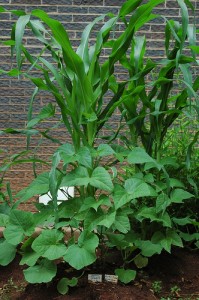Your basic green beans (Phaseolus vulgaris), also known as runner beans, string beans or snap beans, are one of the most popular backyard vegetables, partly because they have hugh yields over a very small area, and partly because growing green beans is so easy.
Both the immature pod and the leaves are edible. The leaves, which are made up of three small leaflets, are quite nutritious and can be used in salads.
Green beans can be divided into bush, or dwarf, varieties and climbing varieties. Generally the climbing plants have higher yields, and their beans are also easier to harvest than on the dwarf varieties, however they do require slightly more preparation – something to climb on. They can also be divided into string and stringless varieties, that latter being more common these days.
Soil Cultivation
Beans can be grown in most soil types, as long as they have good drainage. The shallow roots needs continuous moisture to create a good harvest, and if moisture is lacking during the growing period flowers will fail to set, however if the soil does not drain well the roots will rot.
Mulching with compost will encourage water retention and protect the shallow root system.The more you mulch, the more roots the beans will put out, making them more resistant to disease and pests.
Digging in compost or organic matter before planting will also help sandy soils retain moisture.
Aspect & Conditions
Beans prefer sunny spots with warm soil.
In most climates, sew seeds when the risk of frost has passed. The seeds will not germinate at less than 15 degrees Celsius. On the other hand with temperatures over 27C, pods may not set, so in tropical areas they may be grown in cooler months.
Crop rotation
In a crop rotation system beans and other legumes follow root vegetables such as onions and carrots, and are followed by tomatoes. In this case the bed will have been gently limed the previous season. Otherwise if the pH is low, you may need to add some lime a month before sewing.
Planting green beans
Beans seeds are planted directly into their final spot in the garden, about 3cm (1 inch) deep)
If sewing in rows, climbing beans should be sewn 15cm apart (6 inches) in rows 1 metre (3 feet) apart. Climbing beans can also be sewn in a pyramid structure, but still need plenty of space between them to prevent fungal dis

eases taking hold. Bush varieties can be sewn 6cm (2-3 inches) apart, in rows spaced at 60cm (2 feet).
For any variety, make sure they are not crowded, which allows fungal diseases to flourish (and incidentally makes it much harder to harvest the pods).
For climbing beans, trellises should be 2.5 metres (8 feet) high. An alternative is to let them climb up corn stalks, which are a good companion plant for green beans (see below). Plant the beans when your corn is already half grown. (This is a Jackie French tip).
Seeds sewn in moist soils should not need more watering until the seedlings appear.
Harvesting
The growing season is around 10-12 weeks. Dwarf varieties mature more quickly than climbers.
Pick frequently to encourage more flowers and larger yields, but be careful not to damage vines by picking too energetically. Pods should snap easily and seeds should not yet be fully developed when picked. Avoid picking in very hot or very cold weather.
Pests
In Australia red spider mite, aphids and bean fly are the main pests. In American you will also contend with the Mexican bean beetle (which you can inspect for and remove by hand) and leaf hoppers.
Companion Planting
- Borage helps repel bean fly and bean mites, and the leaves can be used as mulch.
- Summer savory helps repel bean beetles, and is also said to improve the flavour and general growth of beans.
- Corn and beans planted together can increase the range and number of predators attacking the pests of both plants.
- Nasturtiums repel bean fly and white fly, as long as the beans plants are higher than the nasturtiums.
- A comfrey mulch will help manage white fly by building up potash levels in your soil, however this may take up to three years to be effective.
Do not plant with
- Any member of the allium family, ie onions, garlic etc, which inhibit the growth of beans.




